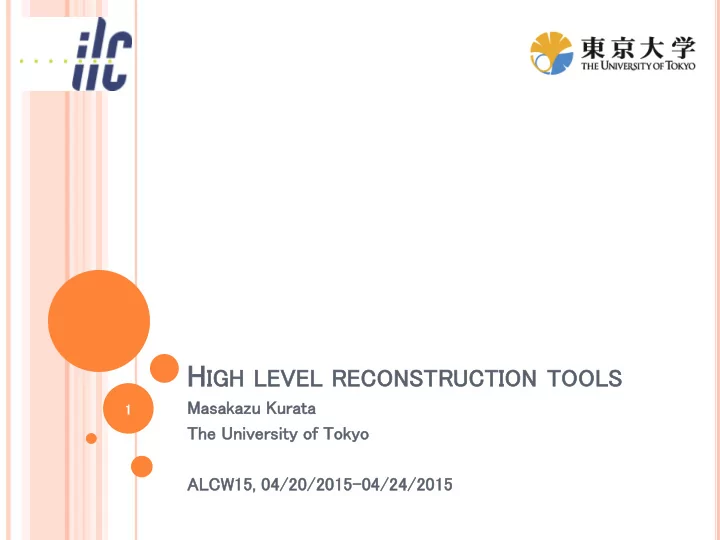

H IGH LEVEL RECON ONSTRUCTION ON TOO OOLS Mas asak akaz azu Kurat ata 1 The U Unive versity y of Tokyo yo ALCW15, 04/20/2015-04/24/2015 04/24/2015
N EXT - ROUND RECONSTRUCTION Public event sample generation – Improved & new reconstruction tools should be included Fixed overlay effect Improved forward tracking Silicon tracking dE/dx using TPC info. Shower profile info. in calorimeters Improved LCFIPlus (Primary vertex smearing) Covering red topics Particle ID can be constructed 2
D E/ DX FROM TPC Fluctuation of dE/dx using various type of tracks Normalized tracks Truncation method is used to avoid landau tail Fluctuations of each particle/each momentum range in simulation: 3 3 – (<5)%!! TDR DR goal al: 5 5% Including detector effect is necessary Electron Momentum dependence of dE/dx Muon for each particle Pion Kao aon Polar angle dependence corrected Proton Num. of Hits dependence corrected 𝑒𝐹 Scale to 𝑒𝑦 = 1.0 for MIP pion 3
S HOWER PROFILE Shower shapes in the calorimeter are different between electron/photon/muon/hadrons Information extraction is based on fitting to cluster hits: Well-known EM shower profile b 1 ( c ( x x )) exp( c ( x x )) exp( dx ) l 0 l 0 t f ( x , x ) ac l t ( b ) In addition, hit based variable is also used(to identify shower start) Shower profile distributions(example) Isolat ated electron Isolat ated electron Fak akes(Had adron trac acks) Fak akes(Had adron trac acks) Longitudinal Transverse Shower max. Absorption length 4 Need to integrate with low energy μ/πseparation technique (see Georgios’ talk)
P ARTICLE ID New variables make Particle ID available -construct Particle ID Overall ID efficiency – using tracks in jets: Electron can be identified almost perfectly(>90%) Muon ID eff. is ~ 70% → due to low energy muons (μ/π separation) Hadron ID effs. are 62% ~ 75% e μπ K p e μπ K p e μπ K p e μπK p e μπK p e μ π K p e μ π Momentum dependence of PID eff. 5 K p
LCFIP LUS IMPROVEMENT DBD LCFIPlus has been successful LCFIPlus moves to the next step with extended collaboration Taikan, Tomohiko, Jan and myself – We have had some meetings already Start some studies There is much room to improve! Now, focusing on Vertex Mass Recovery using pi0s Flavor separation in the case of 0vtx jet Vertex finding efficiency improvement itself Particle ID is one of the key to flavor tagging improvement Pi0 reco. is other key 6
V ERTEX MASS RECOVERY Using pi0s which escape from vertices Need to choose good pi0 candidates – construct pi0 vertex finder Key issue – pi0 kinematics, very collinear to vertex direction Pi0 momentum Pi0 from vertex Pi0 from primary Momentum sum of other products Vertex direction θ(π 0 , vtxdir) (rad) Particle ID is the other key to classify vertices Different particle patterns have different vertex mass patterns e .g.) K+π v.s . π+π K+π π + π Construct Pi0 Vertex finder 7 using MVA
V TX MASS Vtx mass distribution example: Difference is coming from mis-pairing of gammas(main source) and mis- attachment of pi0s(sub-source) 3 tracks in bjet Reconstruction Perfect γ combinatorial problem has large effect Pi0 finder Good pi0 reco. @low energy is necessary (see. Graham’s talk) Effect on flavor tagger Convert vertex mass to recovered Improvement can be obtained Nvtx==1 jets 8
0 VTX JET FLAVOR SEPARATION Flavor separation of 0vtx jet is most difficult situation Only impact parameter implies the existence of secondary vertices for flavor separation BNess tagger is good for such a situation Focus on individual tracks and evaluate jet flavor only using single track Highest score track Construct BNess tagger using MVA bjet cjet c jet separation is necessary at ILC ljet Effect on flavor tagging Some improvement for b-c separation Drastically improve b-l separation @500GeV 9
N EW VERTEX FINDING ALGORITHM Adaptive Vertex Fitting – include multi-vertex effect Estimation of track probability on the vertices is not simple χ 2 , but weight function: k-th track’s weight on n -th vertex At the same time, using BNess tagger for fake track rejection Preliminary result: num. of jets with vertices @500GeV method Bjet with 2vt vtx Bjet with 1vt vtx total al Nominal Algorithm 11715 21734 33449 AVF&BNess 14671 20153 34824 ~ 22% increase for 2 vtx jets ~ 8% decrease for 1vtx jets ~ 4% increase for total num. of jets with vtx Fake track rate per vtx method Bjet with 2vt vtx Bjet with 1vt vtx Nominal Algorithm 0.018 ± 0.001 0.035 ± 0.001 AVF&BNess 0.021 ± 0.001 0.034 ± 0.001 10 10 More study is necessary Reco. vertex quality check, c jet vertexing , fake track bias, etc…
S UMMARY For physics results improvement, we can use various aspects of detectors: dE/dx in TPC and shower profile in cal. Studying particle ID: Hadron ID eff. is 62% ~ 75% Particle ID eff. is >60% @1GeV/c-20GeV/c range Flavor tagger improvement: LCFIPlus is going to next step Vertex mass recovery using pi0s It is hopeful! Some improvement on flavor tagging can be provided Flavor separation in 0vtx jet case Introduce BNess tagger to identify jet flavor with single track Both b-c and b-l separation will be improved New algorithm for vertex finding Vertex finding eff. will be improved with same fake track rate as nominal algorithm Need to check vertex quality and vertexing c jet case We need to make the most of ILD detector performance and to explore 11 11 the possibility of physics results improvement!
BACKUPS 12 12
Recommend
More recommend